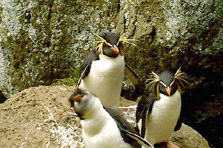(1) detect and record significant changes in critical components of the marine ecosystem within the Convention Area, to serve as a basis for the conservation of Antarctic marine living resources; and
(2) distinguish between changes due to harvesting of commercial species and changes due to environmental variability, both physical and biological.
CEMP’s major function is to monitor the key life-history parameters of selected dependent species (‘indicator species’, which are likely to respond to changes in the availability of harvested species).
To distinguish between changes due to harvesting and those due to environmental variability, the program also monitors similar parameters for harvested species as well as harvesting strategies and environmental parameters.

CCAMLR has developed CEMP standard methods and established sampling sites. The ‘CEMP Standard Methods’ include data collection methods and procedures for data analysis aimed at yielding standardised information for comparisons across species and sites.
Data may be submitted via airmail using paper forms, or via email (data@ccamlr.org) using electronic forms (eforms).
CEMP sites are located in three Integrated Study Regions (ISR) and in a network of additional sites. CCAMLR regularly reviews the analyses of CEMP data, and conducts annual assessments which attempt to document ecosystem ‘health’.
Trends in CEMP parameters and the occurrence of anomalous years in the monitored parameters are identified by species and site.
Changes which reflect natural environmental variation and those which may reflect the effects of harvesting are examined. Procedures are being developed to take account of both environmental variation and harvesting effects in the formulation of conservation measures governing commercial harvesting in the Convention Area.
FURTHER READING
Agnew, D.J. (1997). The CCAMLR Ecosystem Monitoring Programme.
Antarctic
Science, 9 (3): 235-242.
Brierley, A. and Reid, K. (1999). Kingdom of krill. New Scientist,
2182: 37-41.
Constable, A.J., de la Mare, W.K., Agnew, D.J., Everson, I. and
Miller, D. (2000). Managing fisheries to conserve the Antarctic marine
ecosystem: practical implementation of the Convention on the conservation of
Antarctic Marine Living Resources (CCAMLR). ICES Journal of Marine Science,
57: 778-791.